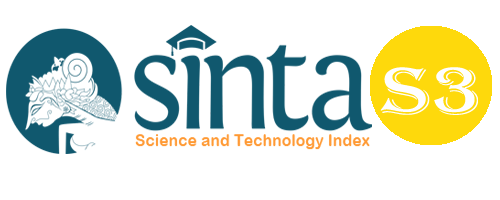Financial Literacy and Loan Terms Affect Msme Formal Credit Access
Abstract
The rapid increase in Micro, Small and Medium Enterprises (MSMEs) in Indonesia is able to encourage economic growth. The existence of government policies on financing Micro, Small and Medium Enterprises (MSMEs) motivates Micro, Small and Medium Enterprises (MSMEs) entrepreneurs to be able to create a good financing system so as to affect the ease of accessing credit. Ease of access to formal credit is important because formal credit providers have more availability of funds than informal credit providers. Access to formal credit carried out on Micro, Small and Medium Enterprises (MSMEs) is also based on the banking behavior of Micro, Small and Medium Enterprises (MSMEs) entrepreneurs who are influenced by financial literacy. Various efforts made by the Office of Cooperatives and MSMEs of Sleman Regency, Yogyakarta Special Region, Indonesia in improving financial literacy include providing financial training that is analyzed for effectiveness in research. This study aims to determine the effect of financial literacy and credit requirements on access to formal credit by Micro, Small and Medium Enterprises (UMKM) in Sleman Regency, Yogyakarta Special Region, Indonesia. The method used in this study is a regression test. The results of this study show that financial literacy and credit requirements can affect access to formal credit by Micro, Small and Medium Enterprises (MSMEs) in Sleman Regency, Yogyakarta Special Region.
Keywords
Full Text:
PDFReferences
Adomako, S., Danso, A., & Ofori Damoah, J. (2016). The moderating influence of financial literacy on the relationship between access to finance and firm growth in Ghana. Venture Capital, 18(1), 43–61. https://doi.org/10.1080/13691066.2015.1079952
Ahmedova, S. (2015). Factors for Increasing the Competitiveness of Small and Medium- Sized Enterprises (SMEs) in Bulgaria. Procedia - Social and Behavioral Sciences, 195, 1104–1112. https://doi.org/10.1016/J.SBSPRO.2015.06.155
Aminda, R. S., Bimo, W. A., Marlina, A., Mahmud, K. S., & Handayani, T. (2022). Determinasi Akses Kredit Formal UMKM Sektor Makanan Minuman Masa Pandemi. Moneter : Jurnal Keuangan Dan Perbankan, 10(2), 52–61. https://doi.org/10.32832/MONETER.V10I2.8543
Angilella, S., & Mazzù, S. (2015). The financing of innovative SMEs: A multicriteria credit rating model. European Journal of Operational Research, 244(2), 540–554. https://doi.org/10.1016/J.EJOR.2015.01.033
Cole, R., Stevenson, M., & Aitken, J. (2019). Blockchain technology: implications for operations and supply chain management. Supply Chain Management, 24(4), 469–483. https://doi.org/10.1108/SCM-09-2018-0309/FULL/XML
Cole, S., Sampson, T., & Zia, B. (2009). Financial Literacy, Financial Decisions, and the Demand for Financial Services: Evidence from India and Indonesia.
Houston, S. J. (2010). Measuring Financial Literacy. Journal of Consumer Affairs, 44(2), 296–316.
Lusimbo, L., & Muturi, M. (2015). Financial Literacy and The Growth of Small enterproses in Kenya: A Case of Kakamega Central Sub – Country, Kenya. International Journal of Economics, Commerce and Management, 824–845.
Madestam, A. (2014). Informal Finance : A Theory of Moneylenders. Journal of Development Economics, 157–174.
Maulida, R., & Arfinto, E. D. (2011). Analisis Faktor-Faktor yang Mempengaruhi Struktur Modal dan Peluang Penggunaan Dana Eksternal Usaha Mikro Kecil Menengah di Kota Semarang [Doctoral Dissertation]. Universitas Dipenogoro.
Monga, M., Dzvimbo, M., and Mashizha, T. (2019). The Dynamics of Gender: A Grassroots Perspective on Economic Resilience and Empowerment of the Tonga People in Kariba. Budapest International Research and Critics Institute-Journal (BIRCI-Journal) Vol 2 (4): 115-124.
Nindy, S. (2021). Pengaruh Inklusi Keuangan dan Literasi Keuangan terhadap Kinerja UMKM pada masa Pandemi Covid-19 (studi kasus pada UMKM Kabupaten Malang. Competitive, 16(2), 59–69. https://doi.org/10.36618/Competitive.V16I2.1287
Oktavianti, V., & Hakim, M. S. (2017). Pengaruh Literasi Keuangan dan Persyaratan Kredit terhadap Akses Kredit Formal pada UMKM di Surabaya. Jurnal Sains Dan Seni ITS, 6(1), D17–D21. https://doi.org/10.12962/J23373520.V6I1.21320
Paramitalaksmi, R., Astuti, W., & Aviva, H. D. (2022). The Influence of Lifestyle and Financial Literacy against Consumptive Behavior of Generation Z in Yogyakarta during The Covid-19 Pandemic. Jurnal Akuntansi, Manajemen Dan Ekonomi, 24(4), 53–61. https://doi.org/10.32424/1.JAME.2022.24.4.6825
Putu, N., Diani, V. E., Dewa, I., Ayu, G., & Pramesti, A. (2022). Pengaruh Struktur Aktiva, Perputaran Modal Kerja, Likuiditas, dan Pendanaan Modal Kerja terhadap Kinerja Perusahaan pada Perusahaan Manufaktur yang Terdaftar di Bursa Efek Indonesia Tahun 2018 – 2020. Kumpulan Hasil Riset Mahasiswa Akuntansi (KHARISMA), 4(3), 45–54. http://e-journal.unmas.ac.id/index.php/kharisma/article/view/5452
Rudianto, R., & Siregar, S. V. (2014). Kualitas Laporan Keuangan UMKM serta Prospek Implementasi SAK ETAP. Jurnal Akuntansi Dan Keuangan Indonesia Universitas Indonesia, 9(1), 1–12.
Salen, A., Lestary, E., & Setyaningrum, F. (2022). Pengaruh Literasi Keuangan dan Inklusi Keuangan Terhadap Kinerja UMKM (Studi Kasus Pada UMKM di Desa Junrejo Kota Batu). https://rinjani.unitri.ac.id/handle/071061/1423
Setyawan Agus, A., Isa, M., Wajdi, W. F. M., Syamsudin, & Nugroho Permono, S. (2015). An Assessment of SME Competitiveness in Indonesia. Journal of Competitiveness, 7(2), 60–74. https://doi.org/10.7441/JOC.2015.02.04
Tinggi, S., & Amm, I. E. (2021). Analisis Faktor Daya Saing, Budaya Keuangan, dan Keputusan Pembayaran Kredit terhadap Peluang Akses Layanan Keuangan UKM Lombok. Sains: Jurnal Manajemen Dan Bisnis, 14(1), 70–86. https://doi.org/10.35448/JMB.V14I1.12543
UU No. 10 Tahun 1998 tentang Perubahan atas Undang-Undang Nomor 7 Tahun 1992 tentang Perbankan [JDIH BPK RI]. (n.d.). Retrieved December 31, 2022, from https://peraturan.bpk.go.id/Home/Details/45486/uu-no-10-tahun-1998
Wollie, G. (2018). The Relationship between Inflation and Economic Growth in Ethiopia. Budapest International Research and Critics Institute-Journal (BIRCI-Journal) Vol I (3): 264-271.
DOI: https://doi.org/10.33258/birci.v6i1.7433
Article Metrics
Abstract view : 35 timesPDF - 4 times
Refbacks
- There are currently no refbacks.

This work is licensed under a Creative Commons Attribution-ShareAlike 4.0 International License.

This work is licensed under a Creative Commons Attribution-ShareAlike 4.0 International License.

_.gif)

















_.gif)



